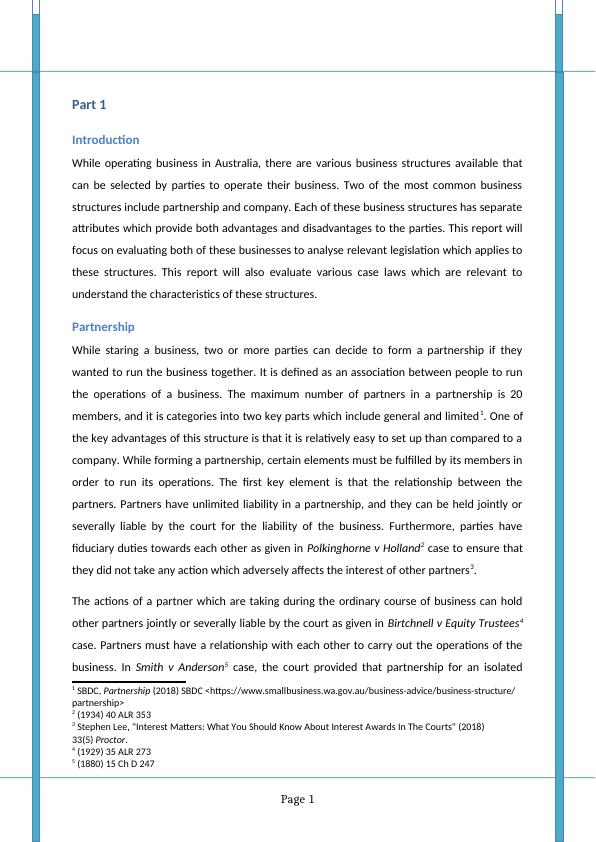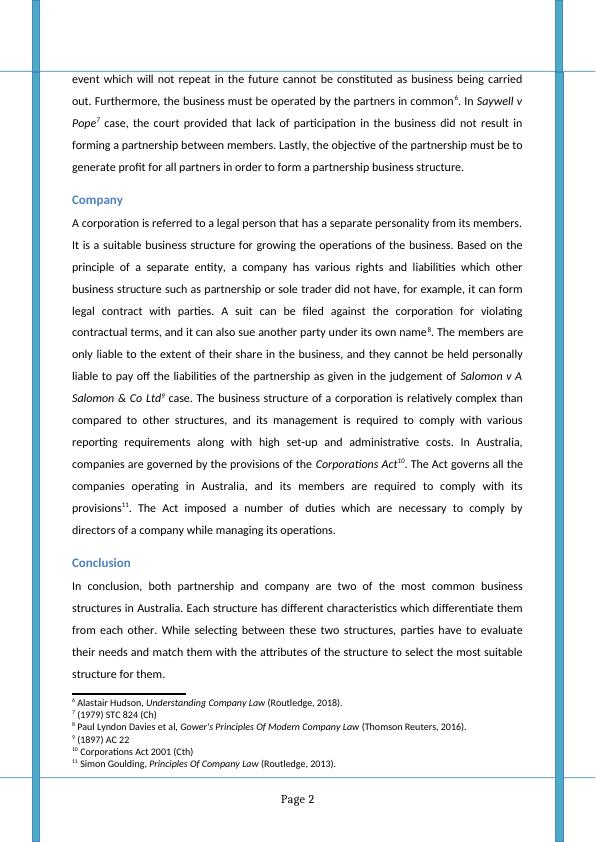Corporation and Business Structure: Partnership and Company
Added on 2023-06-10
13 Pages3656 Words107 Views
Corporation and Business Structure

Part 1
Introduction
While operating business in Australia, there are various business structures available that
can be selected by parties to operate their business. Two of the most common business
structures include partnership and company. Each of these business structures has separate
attributes which provide both advantages and disadvantages to the parties. This report will
focus on evaluating both of these businesses to analyse relevant legislation which applies to
these structures. This report will also evaluate various case laws which are relevant to
understand the characteristics of these structures.
Partnership
While staring a business, two or more parties can decide to form a partnership if they
wanted to run the business together. It is defined as an association between people to run
the operations of a business. The maximum number of partners in a partnership is 20
members, and it is categories into two key parts which include general and limited1. One of
the key advantages of this structure is that it is relatively easy to set up than compared to a
company. While forming a partnership, certain elements must be fulfilled by its members in
order to run its operations. The first key element is that the relationship between the
partners. Partners have unlimited liability in a partnership, and they can be held jointly or
severally liable by the court for the liability of the business. Furthermore, parties have
fiduciary duties towards each other as given in Polkinghorne v Holland2 case to ensure that
they did not take any action which adversely affects the interest of other partners3.
The actions of a partner which are taking during the ordinary course of business can hold
other partners jointly or severally liable by the court as given in Birtchnell v Equity Trustees4
case. Partners must have a relationship with each other to carry out the operations of the
business. In Smith v Anderson5 case, the court provided that partnership for an isolated
1 SBDC, Partnership (2018) SBDC <https://www.smallbusiness.wa.gov.au/business-advice/business-structure/
partnership>
2 (1934) 40 ALR 353
3 Stephen Lee, "Interest Matters: What You Should Know About Interest Awards In The Courts" (2018)
33(5) Proctor.
4 (1929) 35 ALR 273
5 (1880) 15 Ch D 247
Page 1
Introduction
While operating business in Australia, there are various business structures available that
can be selected by parties to operate their business. Two of the most common business
structures include partnership and company. Each of these business structures has separate
attributes which provide both advantages and disadvantages to the parties. This report will
focus on evaluating both of these businesses to analyse relevant legislation which applies to
these structures. This report will also evaluate various case laws which are relevant to
understand the characteristics of these structures.
Partnership
While staring a business, two or more parties can decide to form a partnership if they
wanted to run the business together. It is defined as an association between people to run
the operations of a business. The maximum number of partners in a partnership is 20
members, and it is categories into two key parts which include general and limited1. One of
the key advantages of this structure is that it is relatively easy to set up than compared to a
company. While forming a partnership, certain elements must be fulfilled by its members in
order to run its operations. The first key element is that the relationship between the
partners. Partners have unlimited liability in a partnership, and they can be held jointly or
severally liable by the court for the liability of the business. Furthermore, parties have
fiduciary duties towards each other as given in Polkinghorne v Holland2 case to ensure that
they did not take any action which adversely affects the interest of other partners3.
The actions of a partner which are taking during the ordinary course of business can hold
other partners jointly or severally liable by the court as given in Birtchnell v Equity Trustees4
case. Partners must have a relationship with each other to carry out the operations of the
business. In Smith v Anderson5 case, the court provided that partnership for an isolated
1 SBDC, Partnership (2018) SBDC <https://www.smallbusiness.wa.gov.au/business-advice/business-structure/
partnership>
2 (1934) 40 ALR 353
3 Stephen Lee, "Interest Matters: What You Should Know About Interest Awards In The Courts" (2018)
33(5) Proctor.
4 (1929) 35 ALR 273
5 (1880) 15 Ch D 247
Page 1

event which will not repeat in the future cannot be constituted as business being carried
out. Furthermore, the business must be operated by the partners in common6. In Saywell v
Pope7 case, the court provided that lack of participation in the business did not result in
forming a partnership between members. Lastly, the objective of the partnership must be to
generate profit for all partners in order to form a partnership business structure.
Company
A corporation is referred to a legal person that has a separate personality from its members.
It is a suitable business structure for growing the operations of the business. Based on the
principle of a separate entity, a company has various rights and liabilities which other
business structure such as partnership or sole trader did not have, for example, it can form
legal contract with parties. A suit can be filed against the corporation for violating
contractual terms, and it can also sue another party under its own name8. The members are
only liable to the extent of their share in the business, and they cannot be held personally
liable to pay off the liabilities of the partnership as given in the judgement of Salomon v A
Salomon & Co Ltd9 case. The business structure of a corporation is relatively complex than
compared to other structures, and its management is required to comply with various
reporting requirements along with high set-up and administrative costs. In Australia,
companies are governed by the provisions of the Corporations Act10. The Act governs all the
companies operating in Australia, and its members are required to comply with its
provisions11. The Act imposed a number of duties which are necessary to comply by
directors of a company while managing its operations.
Conclusion
In conclusion, both partnership and company are two of the most common business
structures in Australia. Each structure has different characteristics which differentiate them
from each other. While selecting between these two structures, parties have to evaluate
their needs and match them with the attributes of the structure to select the most suitable
structure for them.
6 Alastair Hudson, Understanding Company Law (Routledge, 2018).
7 (1979) STC 824 (Ch)
8 Paul Lyndon Davies et al, Gower's Principles Of Modern Company Law (Thomson Reuters, 2016).
9 (1897) AC 22
10 Corporations Act 2001 (Cth)
11 Simon Goulding, Principles Of Company Law (Routledge, 2013).
Page 2
out. Furthermore, the business must be operated by the partners in common6. In Saywell v
Pope7 case, the court provided that lack of participation in the business did not result in
forming a partnership between members. Lastly, the objective of the partnership must be to
generate profit for all partners in order to form a partnership business structure.
Company
A corporation is referred to a legal person that has a separate personality from its members.
It is a suitable business structure for growing the operations of the business. Based on the
principle of a separate entity, a company has various rights and liabilities which other
business structure such as partnership or sole trader did not have, for example, it can form
legal contract with parties. A suit can be filed against the corporation for violating
contractual terms, and it can also sue another party under its own name8. The members are
only liable to the extent of their share in the business, and they cannot be held personally
liable to pay off the liabilities of the partnership as given in the judgement of Salomon v A
Salomon & Co Ltd9 case. The business structure of a corporation is relatively complex than
compared to other structures, and its management is required to comply with various
reporting requirements along with high set-up and administrative costs. In Australia,
companies are governed by the provisions of the Corporations Act10. The Act governs all the
companies operating in Australia, and its members are required to comply with its
provisions11. The Act imposed a number of duties which are necessary to comply by
directors of a company while managing its operations.
Conclusion
In conclusion, both partnership and company are two of the most common business
structures in Australia. Each structure has different characteristics which differentiate them
from each other. While selecting between these two structures, parties have to evaluate
their needs and match them with the attributes of the structure to select the most suitable
structure for them.
6 Alastair Hudson, Understanding Company Law (Routledge, 2018).
7 (1979) STC 824 (Ch)
8 Paul Lyndon Davies et al, Gower's Principles Of Modern Company Law (Thomson Reuters, 2016).
9 (1897) AC 22
10 Corporations Act 2001 (Cth)
11 Simon Goulding, Principles Of Company Law (Routledge, 2013).
Page 2

Page 3

End of preview
Want to access all the pages? Upload your documents or become a member.
Related Documents
Business and Corporate Lawlg...
|8
|1856
|428
Corporation and Business Structurelg...
|12
|3444
|476
Liability of Partnership and False Advertisement: Legal Analysislg...
|9
|1941
|237
Corporations and Business Structureslg...
|7
|2245
|59
Comparison of Business Structures: Partnership, Trust and Companylg...
|14
|3742
|481
Business Law Assignment: Liability of Partnership, Legal Remedies, Unconscionable Conduct, and Promissory Estoppellg...
|8
|1945
|127
